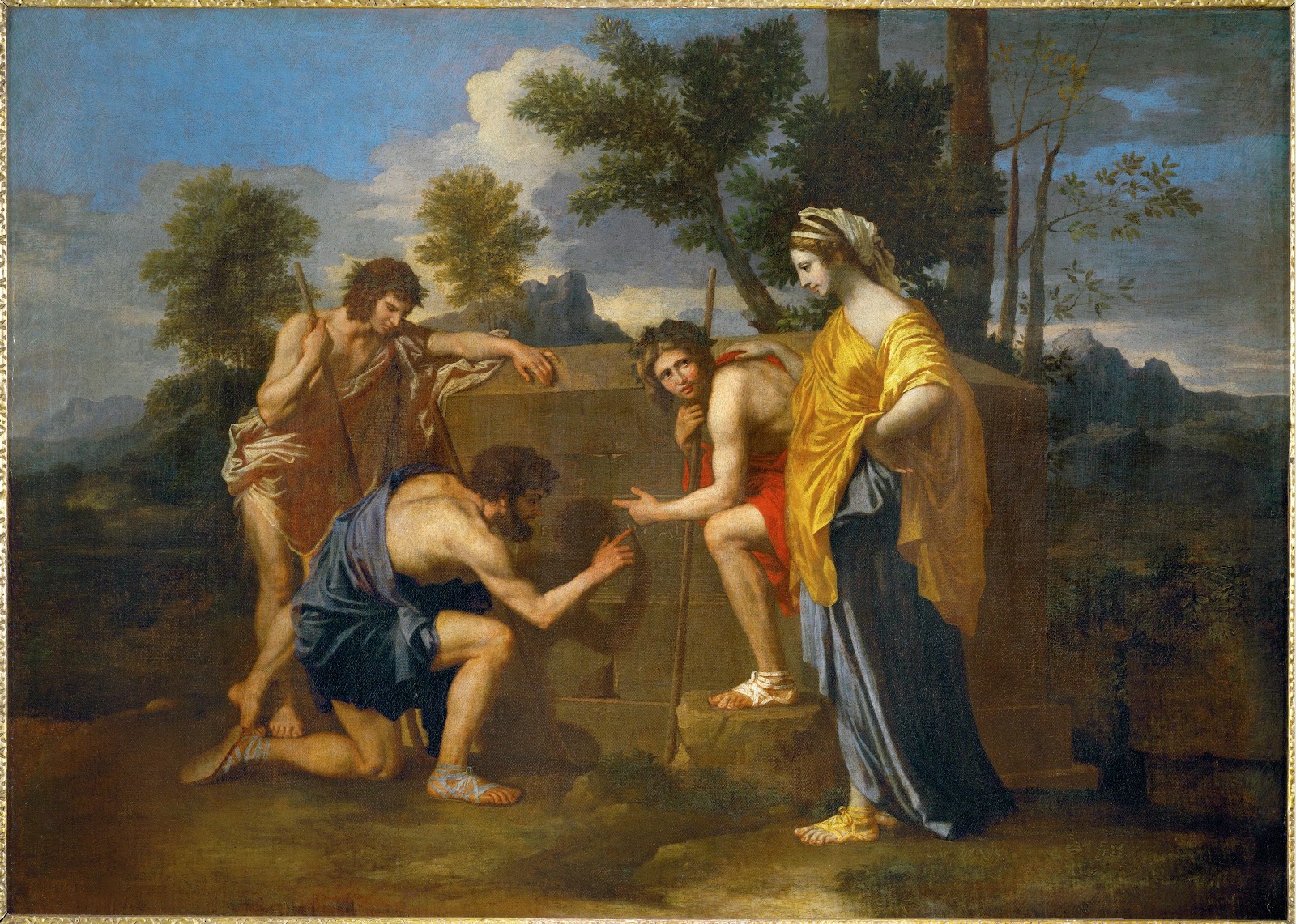Many events occurred during The Classical Era. The rise of the middle class (1700s) was one of them. Increased income influenced people from being peasants to the middle class, and they were able to invest their time in art, music, and things that they desire.
There are two types of art in the Classical Era and the rise of the middle class, Rococo Art and Neoclassical Art. Rococo Art consisted of curving forms, pastel colors, and a reflection of the rich and leisure of the aristocracy. The Rococo Art represented power, playfulness, and sensuality. The rise of the middle class was prompted by the Neoclassical movement because of their disgust with the aristocracy. Neoclassical art represented good deeds, heroism, and moral virtue. The art itself consisted of linear lines and sober colors.
Et in Arcadia Ego by Nicolas Poussin (1637-38)
The piece above was painted by Nicolas Poussin, the leading painter of the classical French Baroque style. Poussin actually painted two versions of the Et in Arcadia Ego, an earlier version (1627) at Chatsworth House, England. The latest piece (above) was commissioned by Giulio Rospigliosi. The piece represents shepherds finding a tomb in Arcadia, reflecting that even in a paradise like Arcadia, there is death. The shepherd pointing to the tomb guides the audience to the main subject of the piece. The women in gold covers represent the wealth and she is unsurprised by the finding because she already understands the truth. This piece follows the neoclassical guidelines with clarity of form, sober colors, and strong linear lines.
This piece was confusing at first glance since I wasn't sure of what I was looking at and what the message of the piece was. The title of the piece is also in a different language so it was difficult for me to analyze. After doing research on the piece, I would definitely own this painting because of its message. Despite the status and wealth of an individual, there is always death in the end, life is not everlasting.
Cornelia, Mother of the Gracchi by Angelica Kauffmann (1785)
The piece above was painted by Angelica Kauffmann, a Swiss Neoclassical painter. She was born in 1740 and received artistic education from her father in her first years. The subject of this piece was the Mother of Gracchi, Pointing to her Children as Her Treasures. The woman on the right is showing off her precious jewelry to Cornelia, then asks Cornelia what her treasures were. Cornelia then points to her children, implying that "the most precious treasures of any woman are not material possessions, but the children who are our future" (Martin 2016). This piece also follows the neoclassical guidelines with linear lines, sober tone, and clarity of forms.
I really like this piece because of the message behind it as well. Cornelia did not grab her jewelry box when asked about her treasures, she reached for her children instead. This says a lot about how Cornelia is as a mother and her beliefs. No matter how much wealth you have, your children will always be your prized possession.
Mr. and Mrs. Andrews by Thomas Gainsborough (1750)
This piece was painted by Thomas Gainsborough, an English portrait and landscape painter. He gained fame and wealth from his painting. Mr. and Mrs. Andrews was Thomas' experiment in combining landscape and "face painting". This piece was left unfinished and was never public until the 20th century. In the painting, two couples pose for a portrait on a calm and sunny day. The couples are Robert and Frances Andrews and the piece represents the young couple's wealth. The couple is on the far right of the painting, allowing Thomas to focus on the representation of the landscape. This piece follows the Rococo style with curvy lines, pastel colors, and asymmetrical flourishes.
I really enjoy the piece but I would not personally own it. The landscape painting really caught my interest because of the spacing. On the other hand, the portrait of the couples are slightly intimidating and they seem emotionless.
Citations
Fernández, G. “Mr. and Mrs. Andrews.” Theartwolf, 2 Aug. 2021, theartwolf.com/masterworks/landscapes/gainsborough-mr-mrs-andrews/.
Martin, Dana, and Dana Martin. “Angelica Kauffmann, Cornelia Pointing to Her Children as Her Treasures.” Smarthistory, 2016, smarthistory.org/angelica-kauffmann-cornelia-pointing-to-her-children-as-her-treasures/#:~:text=To%20her%20visitor’s%20chagrin%2C%20when,children%20who%20are%20our%20future.
McCouat , Philip. “Masters of All They Survey: Gainsborough’s Mr and Mrs Andrews.” Journal of ART in SOCIETY, 2022, www.artinsociety.com/masters-of-all-they-survey-gainsboroughrsquos-mr-and-mrs-andrews.html.





I really enjoyed the first painting by Poussin, it has hints of both Rococo and Neo-Classicism. The rich gold color of the cloak and landscape background is like a remnant of that time period but it also has the message that even in Arcadia, not all is perfect. I also wrote on Kauffmann's Cornelia. I enjoyed this piece immensely because as a mother who does not have all the riches in the world, it is a relatable thing to present my child as my prized possession. The fact that Cornelia had wealth and still chose her children, is remarkable and really tells of the strong morality woven into art in those times.
ReplyDelete